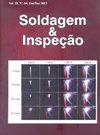加入纳米颗粒的钴基高温合金(钨铬钴合金6)粉末用PTA熔融
IF 0.3
4区 材料科学
Q4 METALLURGY & METALLURGICAL ENGINEERING
引用次数: 1
摘要
2020; 25: e2514。https://doi.org/10.1590/0104-9224/SI25.14摘要:纳米技术是技术发展和应用领域的材料,从1到100纳米的至少一个维度。纳米颗粒在工程上的应用重点是开发具有特殊性能的新材料,可作为焊接领域的填充材料。在这种情况下,本研究有助于焊珠沉积之前的阶段。本研究旨在利用胶体加工技术,将陶瓷纳米颗粒(zro2)插入钴基高温合金(Stellite 6)中,并研究这种“纳米复合材料”的凝固情况。采用PTA熔备4种圆柱形填充材料:添加铁载体的Stellite 6和未添加铁载体的Stellite 6,分别为体积为1%、2.5%和7.5%的陶瓷纳米颗粒(zro2)。通过光学、扫描电镜、场发射(SEM-FEG)、x射线衍射(XRD)和维氏显微硬度对熔融材料进行了表征。结果表明:胶体处理技术可以有效地将zro2纳米颗粒粘附在掺杂Stellite 6的载体Fe颗粒上,并研究了微观组织细化、物相与显微硬度之间的关系本文章由计算机程序翻译,如有差异,请以英文原文为准。
Co-based Superalloy (Stellite 6) Powder with Added Nanoparticles to be Molten by PTA
2020;25:e2514. https://doi.org/10.1590/0104-9224/SI25.14 Abstract: Nanotechnology is the domain of technological development and application of materials which go from 1 to 100 nm in at least one of their dimensions. The use of nanoparticles in engineering focuses on the development of new materials with special properties, which can be used as filler materials in the welding field. In this context, this study contributes to the stage preceding the deposition of the weld beads. This work aims to insert, using the colloidal processing technique, ceramic nanoparticles (ZrO 2 ) into a Co-based superalloy (Stellite 6) and study the solidification of this “nanocomposite”. 4 filler materials in the shape of compacted cylinders were melted by PTA: Stellite 6 with added Fe carriers with ceramic nanoparticles (ZrO 2 ) (1%, 2.5% and 7.5% volume) and Stellite 6 without any additions. The molten materials were characterized through optical and scanning electron microscopy with field emission (SEM-FEG), XRD and Vickers microhardness. The results show that the colloidal processing technique was effective in adhering the ZrO 2 nanoparticles to the carrier Fe particles, which were mixed with Stellite 6, as well as the relationship between microstructure refinement, phases and microhardness
求助全文
通过发布文献求助,成功后即可免费获取论文全文。
去求助
来源期刊

Soldagem & Inspecao
工程技术-冶金工程
CiteScore
1.00
自引率
16.70%
发文量
13
审稿时长
12 weeks
期刊介绍:
The Journal Soldagem & Inspeção (S&I) js a techno-scientific journal created in 1995. Printed issues of this journal are distributed free of charge to libraries in Brazil, Latin America and the Iberian Peninsula. It has been printed regularly every quarter since September, 2002, and, since the beginning of 2007, its electronic version is available in the address: (http://www.abs-soldagem.org.br/s&i/). The journal is sponsored by the Brazilian Welding Association (ABS).
Since its creation several well known professionals working in welding contributed with the Journal Soldagem & Inspeção and its editorial board crosses the Brazilian borders. During its evolution the Journal received ta special contribution from the Editors-in-chief : Ronaldo Paranhos, Américo Scoti, Paulo Modenesi e Alexandre Bracarence. Since January 2012 the Editor-in-chief is Ana Sofia C. M. D’Oliveira, Full professor at Universidade Federal do Paraná (UFPR) . Her work focus mainly on Hardfacing and Physical Metallurgy. The jornal Soldagem & Inspeção also counts with 10 Associate Editors and a fix Editorial board of referees. short-term (Ad Hoc) referees can be invited to evaluate some papers submitted to the journal.
The Soldagem & Inspeção journal is the scientific divulgation channel of the Brazilian Welding Association (ABS). It aims to publish original papers related to the scientific and technological development of welding, inspection, and related fields. Review papers or letters on current and controversial subjects are also published in the Journal.
Its abbreviated title is Soldag. insp. (Impr.), which should be used in bibliographies, footnotes and bibliographical references and strips.
 求助内容:
求助内容: 应助结果提醒方式:
应助结果提醒方式:


